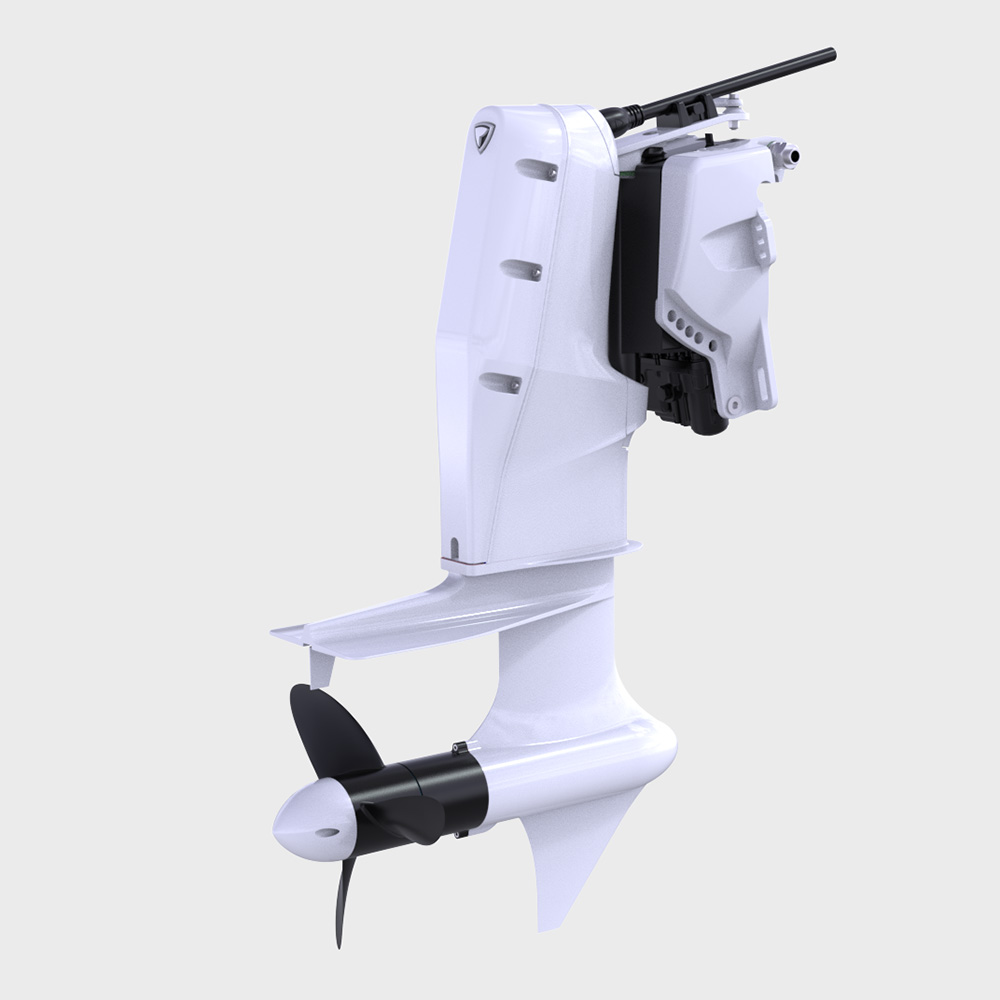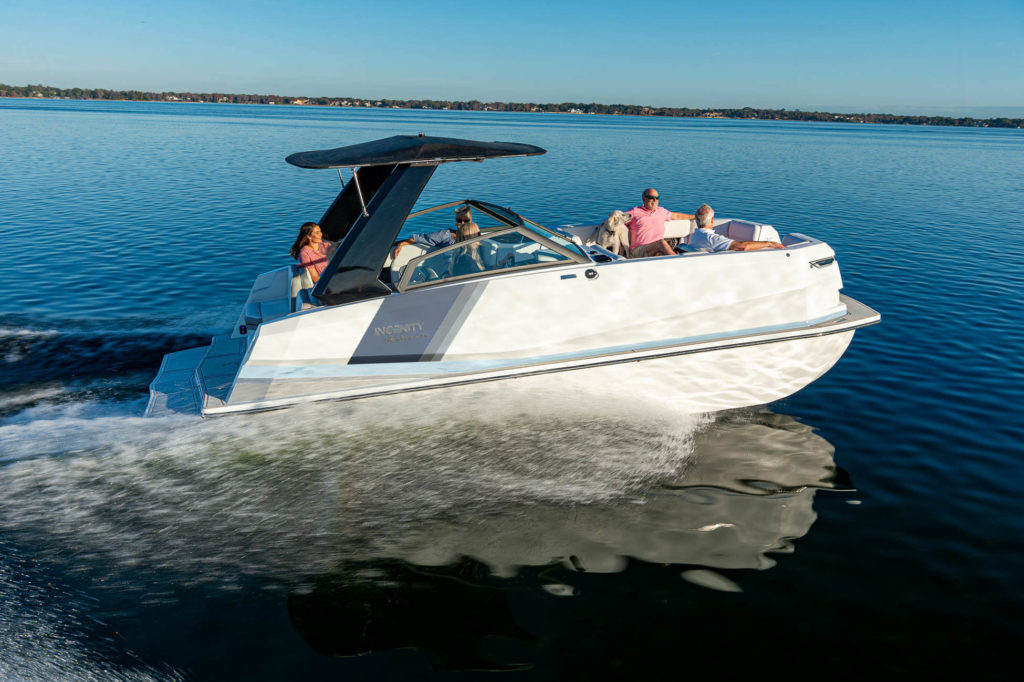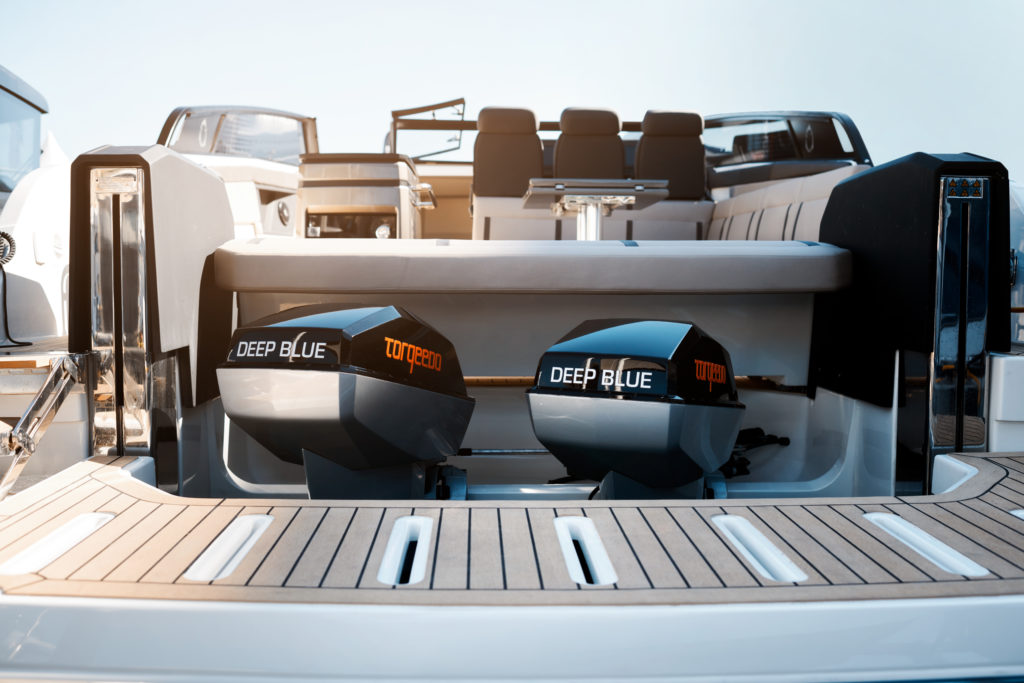A new era of power

By Adam Quandt
Peanut butter and jelly, Mike & Ike, yin and yang, all things we’ve known to go together. But water and electricity? Not so much. However, with the help of new technologies, new partnerships and much more, marine manufacturers are changing that mindset.
With an emphasis on creating more environmentally-friendly products to meet an evolving consumer expectation, boat and engine builders across the recreational boating industry are increasingly exploring new, alternative and eco-friendly power sources on the water.
“Gen X and Millennials are coming to expect more sustainability and environmentally-friendly options. If you don’t change your mindset and start designing and building boats around electric, we’re going to lose the upcoming consumers,” Torqeedo marketing and communications manager Tess Smallridge said.
Since 2005, Torqeedo has worked to explore the most in new technologies in the realm of marine electric propulsion.
“We took a big leap of faith 16 years ago and said ‘hey we’re going to be the first to really branch into this whole new movement of electric mobility on water’ and I will say from the early days of having just one single motor in one small segment, we’re now an over $100 million company, we’ve sold 250,000 units worldwide and we’re in over 44 countries around the globe,” Torqeedo president of U.S. operations Steve Trkla said.
And while electrification isn’t completely new to the marine industry, it’s quickly building momentum across major manufacturers as new technologies develop in the marine industry and the auto industry brings electrification capabilities to a completely new level.
“Electrification is strategically important to Brunswick and represents the next step forward in our evolution in the marine industry. We are pursuing the opportunity from several directions,” Brunswick Corporation chief sustainability officer Jennifer Koenig said.
Most recently from the Brunswick Corporation camp, Mercury Marine unveiled the Avator electric outboard concept earlier this year at the Discover Boating Miami International Boat Show.
“We are excited to formally announce this bold new phase of our vision for the future that only Mercury Marine can deliver,” Mercury Marine president Chris Drees said during the announcement. “Electrification is strategically important to us, and this concept provides a first look at how we intend to deliver on our commitment to being the industry leader in both internal combustion products and electric propulsion. We are taking efficiency to a new level, opening up new ways to enjoy the boating experience.”
Mercury Marine is anticipating five production models of the Avator electric outboard concept to launch by the end of 2023 and another three by the end of 2025.
On the boat side of Brunswick, Koenig told Boating Industry that the company anticipates launching four boat applications with electric propulsion systems by year-end 2023, and will continue to deliver more boats with increasing horsepower and industry-leading fully integrated concepts over the next several years.
In 2021, Yamaha’s CommandBlue advanced engineering and design philosophy led to the U.S. introduction of Yamaha Marine’s HARMO electric outboard design. Coupling a 48-volt power supply with a high-yield, low-drag 3.7-kilowatt motor, HARMO’s rim-drive and specially encased impeller provide an incredible 225 pounds of static thrust – the equivalent of a conventional 9.9-horsepower gas-powered motor.
“HARMO is the perfect system for horsepower or internal-combustion restricted waterways,” said Ben Speciale, president, Yamaha Marine U.S. Business Unit. “Ultimately, it is up to our boat builder customers to decide how to integrate it into their boats, and we are eager to see the result.”
Some engine manufacturers like Volvo Penta have taken to exploring a mix of both hybrid and fully electric alternatives when it comes to the next generation of marine propulsion.
“We expect to see a major shift in business models and the marine industry as a whole by 2030. The shift has already started for commercial vessels across a range of areas like offshore energy, city transit, shipping, etc. The tipping point we see for 2030 is when we anticipate a significant increase in hybrid and electric boating also for consumers – a change that we welcome,” Volvo Penta vice president of marine sales Jens Bering said. “We are using the strength of the Volvo Group to enhance our sustainability journey, where we have the chance to leverage competence and expertise as we address the unique opportunities – in line with the latest scientific evidence.”
The push for new propulsion on the water has also allowed for new players to enter the space. During 2021’s IBEX, Vision Marine Technologies put its E-Motion powertrain technology on full display and has been expanding ever since.
In early June 2022, Limestone Boat Company announced its successful completion of sea trials for its Vision Marine electric outboard-powered Aquasports 2100CC. Shortly after in July, Groupe Beneteau announced a new partnership with Vision Marine to integrate the high-power electric outboards on several models across its portfolio.
“Our high-end technology adapted from the state of the art automotive market is the driver of our partnership with Groupe Beneteau. The E-Motion propulsion system is not only a motor and a high voltage battery, but also a fully optimized powertrain system designed to increase performance and reduce maintenance. We have worked hard with McLaren Engineering and its parent company Linamar Corp. to design a very secure and easy to use system. This will change the way consumers go boating,” stated Xavier Montagne, COO of Vision Marine. As time goes on, it seems partnerships and collaboration will be the name of the game when it comes to the recreational boating industry and alternative power sources and next-generation propulsion.
“The environmental challenge is multi-faceted, and our solutions need to be as well. Each company will bring their own technical solutions, but it will take the industry and perhaps also legislative support,” Volvo Penta’s Bering said.
In late 2021, General Motors announced it had acquired a 25% ownership stake in Pure Watercraft, a Seattle-based company that specializes in all-electric boating. The collaboration will leverage Pure Watercraft’s innovative marine propulsion technology and experience in the commercial marine industry with GM’s engineering, supply chain and manufacturing capabilities. The two companies will develop and commercialize battery electric watercraft, integrating GM technology into a variety of applications, helping to accelerate the industry’s transition to electric mobility.
“GM’s stake in Pure Watercraft represents another exciting opportunity to extend our zero-emissions goal beyond automotive applications,” said Dan Nicholson, GM vice president of Global Electrification, Controls, Software and Electronics. “Building upon GM’s existing efforts to strategically deploy our technology across rail, truck and aerospace industries, the combined expertise of these two enterprises should result in future zero-emissions marine product offerings, providing consumers with more choice than before.”
Though under one Correct Craft umbrella, the partnership between brands is increasingly important when it comes to the company’s Ingenity all-electric boats. After debuting in 2020, Ingenity has earned an increasing spotlight in the marine industry, including Boating Magazine’s Boat of the Year in 2021 for its Ingenity Super Air Nautique GS22E.
“The Nautique GS22E is incredible. It shows what’s possible with fully electric propulsion, but this is only the beginning,” Ingenity president Sean Marrero said during an announcement of an increase in the company’s build capacity to support growing demand for more sustainable boating solutions. “Not only will the new building double our current production space, it also gives us flexibility to scale for what’s to come. Our team cannot wait to share all the many exciting projects that are ahead.”
Seeing the mindsets of not only the consumer, but a good portion of the industry itself change when it comes to alternative power and propulsion has been a welcome sight to the marine electric pioneers at Torqeedo, according to Trkla.
“There’s still a way to go, but all of the recent momentum certainly legitimizes that this is where we’re heading as an industry, and it’s all good for the industry overall,” Trkla said. “What’s important is what is also needed beyond just producing biofuels, hydrogen cells, solid-state batteries. The technology advancements also must come from the boatbuilders’ mindsets. Years ago, boatbuilders simply weren’t designing boats around systems and now we’re seeing builders take that new approach of designing and building around electric systems.”
Aside from some continued technological hurdles when it comes to building boats around alternative power and propulsion, some of the biggest challenges for the marine industry and next-generation propulsion are in infrastructure.
“When we look specifically at the challenge of charging infrastructure, that will certainly take an industry-wide effort to push forward. We are on a journey where technology will continue to evolve and utilizing the appropriate technology for customers and applications will be key – education will also play a large role in this delicate balancing act,” Bering said. “Outside of ‘how fast’ or ‘how far can it go’, there’s the challenge as a full systems supplier to provide a consistent user experience similar to our existing products so that it’s not only easy and enjoyable for the customer to use but also easy to install and service.”
Torqeedo’s Trkla did note that despite the need for further growth, the marine industry does have an advantage in terms of infrastructure in electric boating.
“The auto industry had to start from absolute ground zero when building infrastructure, whereas we in marine, we already have electricity at the docks. It already exists and we have taken extreme advantage of that,” Trkla said. “We have things up to 240V at many marinas today already, and that certainly helps us in our low-voltage space and we’ve taken advantage of that. But if we’re really going to take recreational boating to match how many Americans boat today, we must bridge the gap of where technology takes us and where infrastructure can also squeeze it in. That would be having high-end electricity at marinas that allow fast charging and be able to have your boat ready to go in an hour.”
Much like many other challenges facing the recreational boating industry, it’s going to take an industry-wide approach to overcoming them. Yet, despite the challenges, the next generation of power and propulsion in the marine environment is right at our door-step, should builders, suppliers and boaters alike wish to answer the call.









